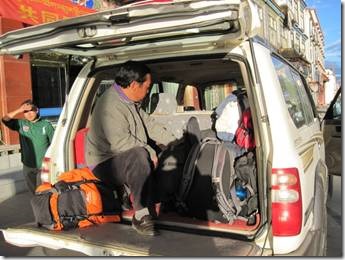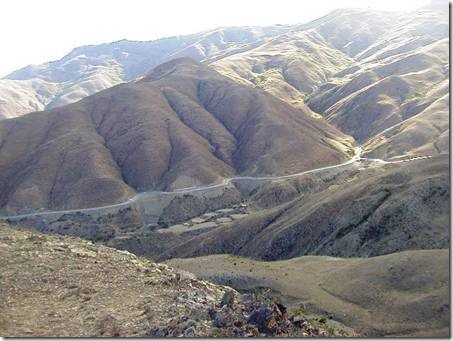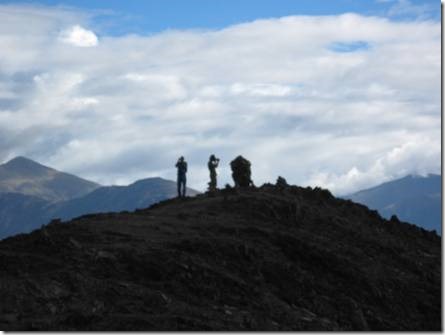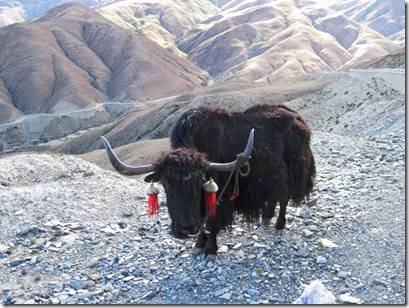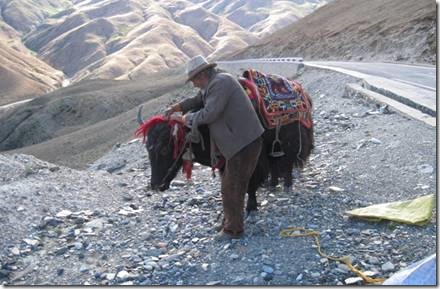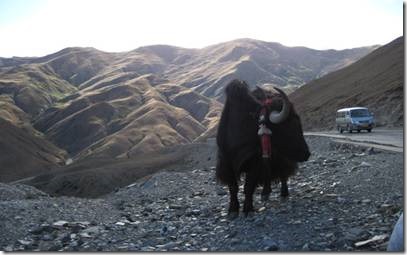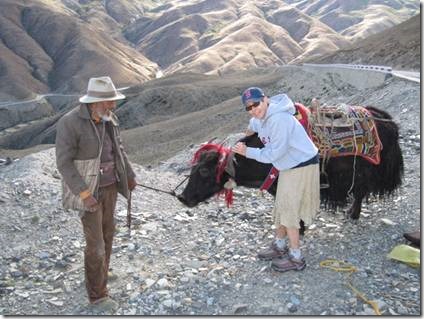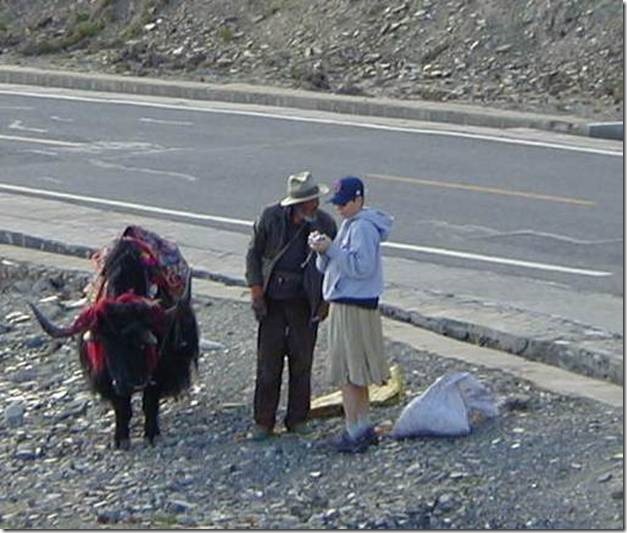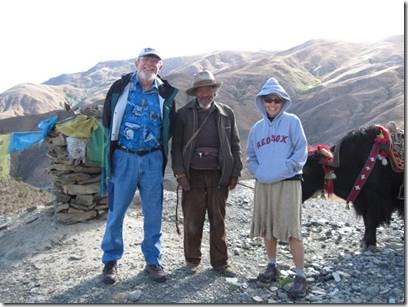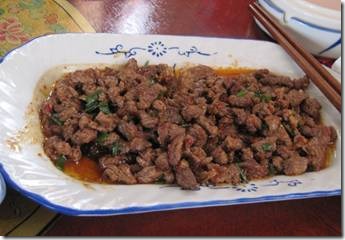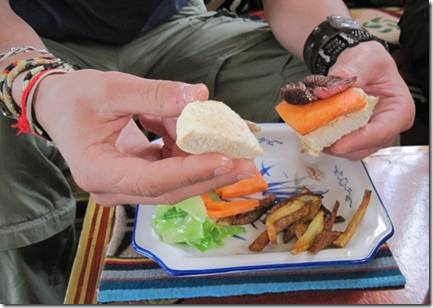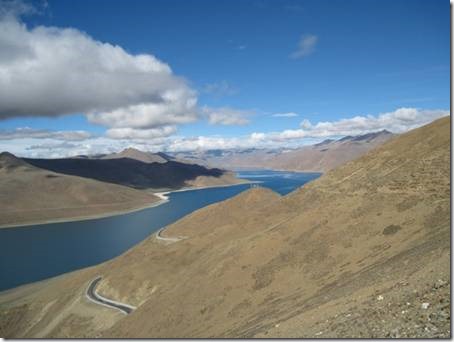Putri Harbour Marina,
Johor, Malaysia
Hi All,
Still no water, but it rained really hard this morning so we finished filling the tanks with our rain catchers. Luckily I had walked really early so didn’t get caught in the downpour. When I left the boat the Sox were down by 2 runs in the first inning. When I came back an hour later they were behind by 7 runs….I think my lucky red Tibet bead only worked while I was in Tibet. With this email we leave Lhasa and begin to see some really amazing desert and mountain scenery, amazing Yamdrok Lake and Korala Glacier where I bought a cup of sweet Tibet tea from a family selling water and hot tea from their tent. We could have stayed hours at each stop but we had lots of miles to cover so was all over way too fast. We left Lhasa before 8 am and mid-morning made our first, though unplanned stop.
Ru
DoraMac
Tibet # 13 Lhasa to Shigatse – but mostly a story about a yak.
June 27th: Lhasa – Gyantse – Shigatse – Group tour
“Highlights: Yamdrok Lake
Today we will drive from Lhasa thru Gyantse to Shigatse, along the road, we will enjoy the blue sky with far away Nianqing Tanggula Mountains. In a minute we will drive along the stunning turquoise like Yamdrok Lake. We will have a look at the stunning Korala Glacier too.
We will keep driving to the second largest city – Shigatse.” Info from our tour itinerary.
6 people and luggage for 6 people crammed into our “not so large” van.
The driver, of course, sat up front and usually either Ronnie or David did also. I usually sat in the middle of the back seat with Randal on one side and one of the guys on the other. Ronnie and David always offered to trade with me and take turns, but my being in the middle made sense and I could lean on Randal. The one time Randal sat up front, I did take a window seat. But Ronnie and David had really good cameras so letting them have the best photo seats made sense. My small camera really didn’t do well while the van was moving and Randal wasn’t taking any photos so we really didn’t need the window seats. Lobsang, our guide, made a nest for himself in back with all of the luggage. Lobsang said that they couldn’t have a roof rack though he didn’t really explain why. It did mean that we could leave some things locked in the van at night so we didn’t have to lug everything into our rooms.
We drove away from Lhasa and began to climb up towards Shigatse, the second largest city in Tibet and our overnight stop. The scenery became desolate and immense and amazing. David and Ronnie were truly enthusiastic cameramen that we took notice of about everything. Lobsang would ask our driver to stop when there was a real photo op. It would have to be something really special because almost every bit of the road was a photo op in my mind. But this was our first one.
Our first photo op stop looking back over the road we’d driven along.
Randal and Ronnie on top of the mountain.
I would have climbed up too, but I had a different interest right at that moment.
This is the real reason we stopped.
We saw an old “uncle” walking his yak. There was a “Ronnie, David, Ruth” chorus of “can we stop!” and we did at the top of the hill where there was a real pull over. Lobsang told us to wait at the van because he knew the man would walk up to us so that he could earn some “photo” money with his yak.
Before the photo, the yak had to be dressed up.
In China and at times here in Malaysia, older people are called Uncle and Auntie which is much nicer than being referred to as “old man” or “old woman” so that’s what I am calling the man with the yak, Uncle. Uncle had walked across to the other side of the road to step behind a wall for a minute. The yak never stopped watching for his return and only trusted us when its owner was standing close. I didn’t approach the yak without the owner being near-by. Those horns are huge and pointed and the yak didn’t have the friendliest expression. They aren’t as docile as cows and probably should be treated more like bulls even if they are female yaks. I have no idea what this is. I asked its name but in a million years couldn’t ever pronounce or spell it. I think the owner made it up on the spot; or Lobsang did when I asked about the name. But I have a “yak thing” just like I still have a “water buffalo” thing so I was happy just to be there.
I could have stayed and “communed” with that yak for quite a while.
We weren’t sure what the saddle was for. Was I supposed to get on? If we’d stayed a bit longer, I’m sure I would have, but we really didn’t have time and no one actually told me to get on, so I didn’t. So it’s still on my to-do list.
Here I am showing the photos to uncle who seemed quite interested to see them.
Now we all pose though the yak could care less.
Lobsang said that photos usually cost 5 yuan and 6 yuan equals a little less than $1 US. The old man didn’t ask for money. I gave him 10 yuan. We did take lots of photos. I don’t know how far he had walked and how much further he would walk. Further along at the overlook for Yamdrok Lake we saw other “uncles with their yaks” and young women with their dogs hoping to earn photo money. I’m glad that we had met the old uncle and his yak just walking along the road. It seemed so much less commercial and you didn’t have to pick which yak to photograph. Meeting on the road made it a “real” interaction. Uncle didn’t speak English so we couldn’t talk with him.
In her book Tibet: Abode of the Gods, Barbara Erickson writes about the importance of the yak to the nomad population.
“Among all the nomads’ possessions the most treasured is the yak, which yields horns, hair, fur, tails, meat, hides, and milk and serves as a mount for riding and a beast of burden. Yak parts and yak milk are transformed into tents, rope, religious artifacts, containers, coracles, boots, blankets, dusters, yogurt, butter, cheese and a cosmetic for women: and yaks, unlike sheep and goats, give milk all year round. Yak milk is twice as rich in butterfat as cow’s milk, but yak meat tastes like beef and yak yogurt is hard to distinguish from supermarket yogurt. Yaks also thrive at high altitudes and low temperatures where cattle would perish. In the lower elevations of Tibet cattle are more common than yaks, but in the highest reaches yaks entirely replace cows, bulls and dzo (a yak/cow mix.)
Yaks are valuable but not always docile. They will balk at their tasks and shake off their loads, or they will toss their formidable horns. They are also difficult to steer because unlike horses, which are guided by a bit, they are steered by reins passed through their noses. Male yaks have larger bodies and horns and longer fur than females, and they are “scary to look at” as one resident of Damzhung put it and truculent. Females (called dri) are timid and manageable. The males are stronger and serve as the chief pack animal. “ p61.
Erickson goes on to say that overgrazing and inbreeding had created problems. The Chinese began working on the problem during the 70s and started a facility known as the Yak Frozen Semen Station so yaks can be artificially inseminated to eliminate the problem of inbreeding which causes a major drop in birthrate and that Tibet’s nomads have been doing better since the program began.
Randal and I ate what was labeled as a “hamburger” which tasted like ground meat mixed with herbs and bread crumbs. Next time, at the same Lhasa restaurant, we ate a “yak burger” and I just asked Randal and he said that it was all meat and we both really did like it. I thought they might have mixed in some filler but he didn’t notice it. During our road trip from Lhasa to Nepal, I ate yak chili and it was great once and terrible the next time. The first restaurant served it ground up and spiced and it was great. The second served sliced yak meat and you couldn’t chew it. I also ate yogurt twice and yogurt cake once and all tasted like yogurt to me though I have no idea what they used. Considering how much I really loved to see the live yaks, I certainly ate my share of yak meat.
Yak chili.
It was plentiful and I had also ordered cheese naan which was naan bread stuffed with cheese and warmed so it melted. Randal had ordered chicken chili and garlic naan. We liked mine best but couldn’t eat half of it because there was quite a bit and it was really spicy so it filled us up with all of our naan. I don’t remember what Ronnie ordered though it came in a portion half the size of mine. But David’s yak burger… I still, even as I write this, laugh over David’s yak burger. He ordered one because Randal and I had raved at the taste and size of the ones we ate in Lhasa. We’ll we weren’t in Lhasa anymore so this is what David got.
David’s yak burger….very very tiny! Where’s the yak?
A “David” is now what Randal and I call tiny portions of food.
When the waitress put the plate down, and David’s came last, like 10 minutes after our food, I took one look at the plate and David’s face and I lost it. I still laugh about it. I think part of David blames our glowing recommendation of yak burgers… But we did share a good deal of our spicy meat and spicy chicken and naan with both David and Ronnie and were glad to do it. I swear that our Lhasa yak burger was as large as his plate.
Next stop, Yamdrok Lake.
After our yak visit we stopped to take photos at Yamdrok Lake but that story will have to wait for the next email.

